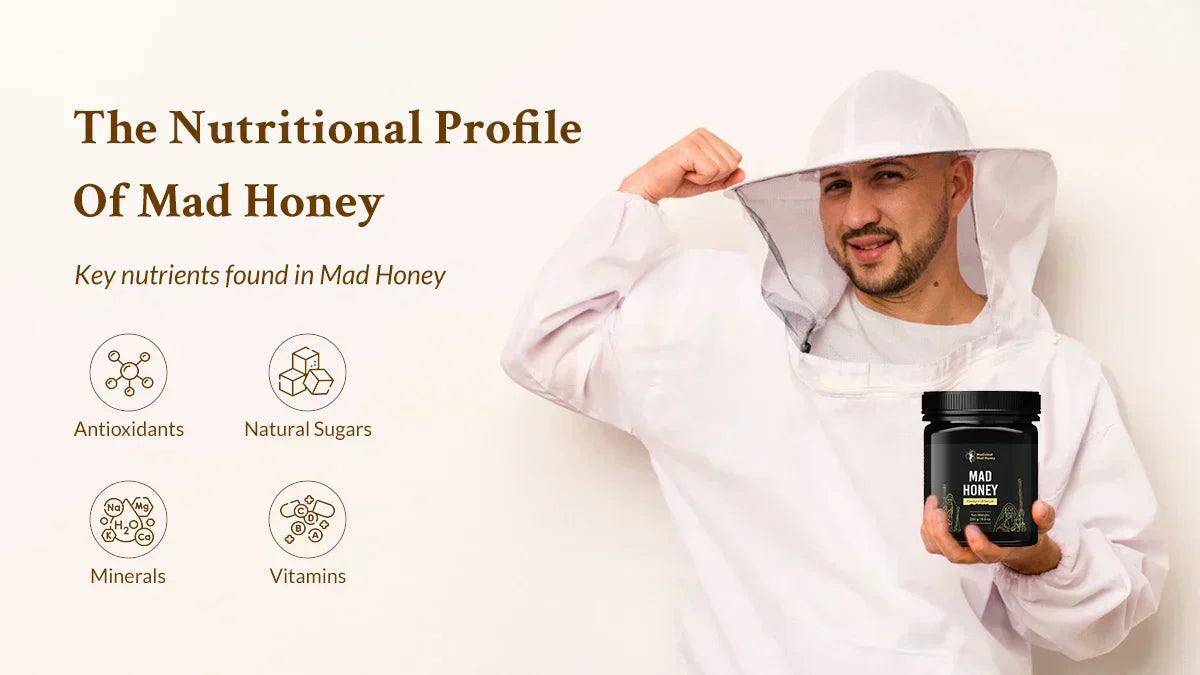Mad Honey, a honey known around the world for its unique and hallucinogenic properties, comes from the parts of Turkey, Nepal and some Himalayan territories.
Honey exists primarily in parts of Turkey along with Nepal and the Himalayan territory because bees draw their nectar from the rhododendrons. The consumption of small quantities leads to mild side effects yet acquiring large amounts poses dangerous medical risks. Experts utilize these amounts for therapeutic benefits although recreational users choose to consume smaller amounts. Across different cultures people have used Mad Honey since ages as a medicine to produce altered therapeutic effects.
Importance of understanding its nutritional values
Knowing mad honey's nutritional composition enables you to grasp its helpful and dangerous features. Natural sugars in mad honey carry essential vitamins and minerals but toxic Grayanotoxin remain as its main potent substance. To make safe consumption choices you should know the nutritional components of mad honey since different regions and toxic levels affect the way it impacts users. By understanding the makeup of mad honey people can leverage this information properly for medication use to achieve both effective doses and prevent toxic outcomes.
What Makes Mad Honey Unique?
Grayanotoxins found in Mad honey produce its distinct quality because they originate from specific rhododendron flowers. Grayanotoxins present in mad honey provide both psychoactive behavior and dangerous toxic elements which distinguish it from conventional honey varieties. Consuming small quantities of mad honey may trigger mild euphoria and hallucinations but consuming larger amounts usually results in dangerous symptoms including dizziness and nausea and low blood pressure. This honey is famous both for its scarcity and its use in different traditions and cultures in Nepal.
The role of Grayanotoxins in its composition
Grayanotoxins function as the principal compound responsible for mad honey's distinctive character. The production of toxins by particular rhododendron plant is the most available flowering plant in the Himalayan regions of Nepal. It is from where bees collect nectar and store it as honey and upon harvest and ingestion people get intoxicated. The chemical grayanotoxin disrupts sodium channels in body cells to cause symptoms including nausea and dizziness. While higher doses lead to hazardous blood pressure drops and psychological symptoms. Mad honey contains grayanotoxins that offer both medicinal effects as well as some side effects.
How the unique geographical origins influence its properties ?
Mad honey exhibits its distinct traits because of its natural origins found primarily in Turkey and in regions extending into Nepal and the Himalayas. Regionally growing rhododendron species differ from other plants that produce grayanotoxins that attract nectar-seeking bees in these mountainous areas. Honey from these regions acquires its grayanotoxin types and concentrations through the combined impact of their climate conditions together with altitude and vegetation. The high altitude environments contain greater toxin concentrations that lead to stronger potency in the obtained honey samples. Tests show that mad honey composition differs across its geographical locations affecting both psychoactive properties and health risks.
The Nutritional Profile of Mad Honey

The nutritional substance profile of mad honey matches regular honey structure with natural sugars (primarily fructose and glucose) creating a base together with small vitamin (including vitamin C) and mineral (such as calcium, potassium and magnesium) content and antioxidant composition. The prominent feature of this honey lies in its grayanotoxin content that simultaneously creates its special toxic and psychoactive features. Grayanotoxins present in mad honey separate this product from ordinary honey because they do not contain this neurotoxin. The level of grayanotoxins present in honey depends on the natural sources the bees visit and the flowers they investigate resulting in changes to both honey's nutritional quality and its safety standards.
Key nutrients found in mad honey
Mad honey contains several key nutrients similar to regular honey including:
Natural Sugars: Principal components of this honey consist of fast-action energy-providing fructose together with glucose.
- Vitamins: A small quantity of vitamin C exists alongside trace B vitamins that promote immune function and supply body energy.
- Minerals: Customers will discover microscopic amounts of Calcium, magnesium, potassium and iron within trace elements of Mad honey that sustain bone wellness alongside muscle performance and systemic body function.
- Antioxidants: Between regular and mad honey types there exist antioxidants that serve as protective agents against free radicals as well as agents that reduce oxidative stress levels.
The most distinct element grayanotoxins exists in mad honey and these toxins provide its signature characteristics even though they act as toxic substances rather than nutrients. The rate of toxin presence depends on which flowers give bees their nectar.
Comparison to regular honey's nutritional components
Regular honey alongside its counterpart mad honey depends on natural sugars (fructose and glucose) as its main nutritional attribute together with small quantities of vitamins C and some B vitamins and elements such as calcium, magnesium and potassium. Each type includes antioxidants which function to combat oxidative stress.
Regular honey exists without grayanotoxins yet this toxic substance is a defining element of mad honey. The particular characteristics of psychoactive and hallucinogenic property found in mad honey emerge from toxic compounds called grayanotoxins. Regular honey possesses known nutritional value which overlaps with mad honey but mad honey's chemical properties along with neurological effects cancels out its standard health benefits. This is why mad honey is equally effective as honey for skin care.

Health Benefits and Uses
Mad honey maintains traditional health applications but the effects on individuals change because of recurring grayanotoxins. Some of the common health uses include:
Stress and Anxiety Relief: Medical research suggests the psychoactive elements of mad honey serve to minimize both stress symptoms and to create a relaxation state that lowers anxiety levels.
- Improved Circulation: A reasonable number of science enthusiasts trust that this types of honey promotes better blood circulation and control of blood pressure because of its organic compounds.
- Digestive Health: Medical practitioners across various cultures use mad honey for digestive support and control of gastrointestinal health problems.
- Aphrodisiac Effects: People have used this substance historically as a sexual enhancer because it boosts both energy and mood levels.
Health agencies have indicated that large quantities of mad honey pose health threats because grayanotoxins trigger nausea and dizziness with additional damaging consequences. Free use of this item needs careful consideration as an essential safety step. It is necessary to understand health benefits and usage of mad honey
Impact on cardiovascular health
The cardiovascular health effects of mad honey are due to grayanotoxins within its composition. Studies alongside traditional honey medicine practices show mad honey might help reduce blood pressure and improve circulation which improves heart health through improved blood circulation. But high levels of grayanotoxins in honey can damage the cardiovascular system and result in potentially fatal blood pressure drops along with dizziness and irregular heartbeat. Heart-related medical benefits can be obtained with moderate honey use but users need to be extremely cautious from unwanted health consequences.
Role in managing hypertension
People have traditionally used Mad honey as a natural therapy for hypertension situations because it may help reduce blood pressure. Scientists believe the grayanotoxins contained in mad honey trigger vasodilation of blood vessels while simultaneously improving circulation. The effect of lowering blood pressure occurs in such situations. The variable strength of mad honey poses a dangerous risk of blood pressure drops which can be fatal in case. So it is always advised against intake of Mad Honey in large amounts.
Antioxidant and anti-inflammatory properties
Mad honey demonstrates antioxidant and anti-inflammatory qualities which overlap with standard honey properties. The antioxidant agents in mad honey especially flavonoids and phenolic compounds work to stop free radicals which decrease stress from oxidation while supporting whole-body health. The substance's properties help strengthen the immune system while decreasing your chances of developing chronic diseases. Through its anti-inflammatory properties mad honey shows potential advantages for arthritis treatment and similar inflammatory conditions. Active compounds found in honey affect human health but their impact strength depends on the honey's source and the amount of active elements present.
Supporting immune function
Natural compounds found in mad honey benefit immune function through their ability to provide antioxidants as well as small vitamin C amounts. Honey's antioxidants fight oxidative stress that harms immunity but its general antimicrobial properties defend the body from microbial infections. Various trace elements including zinc and iron which occur naturally in mad honey help develop appropriate immune system activity. When using mad honey to support immunity you need to maintain a moderate approach because grayanotoxins could lead to health risks.
Mad Honey and Digestive Health
Traditionally people have used mad honey as an agent to maintain digestive health because certain cultures believe it provides relief to gastrointestinal problems. Through its gentle antimicrobial activity the substance helps control the balance of gut bacteria which can improve digestive health by reducing inflammation along the digestive tract. The organic sugars contained in mad honey together with its antioxidants contribute to forming a healthy gut environment. The consumption of mad honey needs moderation because grayanotoxins exist in the product and large amounts could result in gastrointestinal discomfort or unwanted reactions.
Benefits for gut health and digestion
The antimicrobial property along with natural enzymes in mad honey seem to create positive effects on gut health and digestion. Third-party studies suggest this product promotes healthy gut bacteria to help digestion and maintain digestive system health. Different antioxidants present in mad honey help decrease inflammation in the digestive tract which provides therapy for mild bloating and indigestive issues. Consuming any amount of grayanotoxins raises safety concerns because they might generate digestive distress and compound into dangerous consequences. For safe consumption of its digestive benefits you should practice portion control.
Use in traditional medicine for digestive issues
Traditional medicine practitioners have incorporated mad honey for treating selected digestive health problems such as indigestion along with stomach ulcers and constipation. The antimicrobial properties help maintain normal gut bacterial levels plus its anti-inflammatory properties reduce digestive tract inflammation. You must treat mad honey with caution because grayanotoxin can affect health if used in large amounts leading to gastrointestinal distress.
Weight Management with Mad Honey
The compounds in mad honey seem to control metabolism and appetite therefore helping individuals manage their body weight. Mad honey contains grayanotoxins that researchers think act as stimulants to enhance the body's energy levels while boosting fat metabolism. Mad honey's reduction of stress along with cortisol balancing effects helps prevent both stress-eating triggers and belly fat formation. To safely control weight through mad honey consumption you need to maintain moderation because the substance has psychoactive effects that raise safety concerns in elevated doses.
Potential effects on metabolism
The grayanotoxins found in Mad honey possess metabolic potential because they interact with nervous system chemistry which possibly leads to increased energy costs. People believe the compounds found in these products could help users lose body fat and work more efficiently with their metabolism. Due to its cortisol level regulation properties mad honey helps prevent chronic stress from causing metabolic disturbances that typically lead to abdominal fat buildup. Because responses differ among individuals and the strength of honey components fluctuates you should exercise caution and stay within moderation to prevent unwanted consequences.
Appetite regulation and weight loss benefits
Under certain conditions Mad honey plays a role in appetite management along with weight reduction because it helps stabilize cortisol levels which regulates hormone-released stress and binge eating habits. A relaxing effect from mad honey consumption would help control emotional eating behaviors. The grayanotoxins in this product have mild stimulating power that leads to increased metabolism which can help users burn fat. While mad honey shows potential weight management benefits it requires careful use because consuming large quantities exposes users to risky psychoactive properties and potential toxicity effects.
Risks and Precautions
The medicinal value of mad honey comes with dangerous health risks because grayanotoxins found in the product trigger toxic responses when eaten at large proportions. According to research, mad honey poisoning symptoms include dizziness, nausea, low blood pressure which can progress to deadly heart arrhythmias in serious cases. Safety levels of grayanotoxins remain difficult to determine because their strength varies among different honey sources. The usage of mad honey must remain careful and limited-based in part because people with cardiovascular disorders or high blood pressure need to exercise special caution. Medicinal use of mad honey requires healthcare professional advice or one should know symptoms of mad honey overdose before consumption.

Identifying symptoms of over consumption
The toxic side effects of grayanotoxins in mad honey show up through symptoms which begin with dizziness and then advance into nausea followed by vomiting and hypotension while leading to sweat production. Mad honey consumption at high doses could lead patients to develop abnormal heart rhythms as well as fainting and slower heartbeat. Several additional symptoms accompany mad honey consumption such as blurred vision and weakness and confusion. Seek immediate medical evaluation because extreme consumption of mad honey results in serious medical complications with reported symptoms. Having controlled amounts of mad honey will keep toxic reactions away.
Safe consumption guidelines
The safe consumption of mad honey depends upon using measured quantities. Health professionals advise beginning with very tiny honey portions usually limited to a teaspoon or less to monitor your body's reaction. You need to check that your source of honey has safe concentration levels of grayanotoxins since the strength varies between sources. Before considering mad honey usage consult with a healthcare provider or avoid it if you have heart disease or hypertension medical history. Overserving honey will increase your risk for toxic outcomes so try very small amounts at first and keep to minimal levels to protect your health. Tell a doctor right away if you notice any poisoning symptoms.
Risks associated with Grayanotoxins poisoning
Neurotoxin present in mad honey known as grayanotoxin affects the central nervous system and cardiovascular parts of the body. Poisoning from mad honey displays itself through dizziness alongside nausea and vomiting and results in low blood pressure and abnormal heart rhythms. Whenever exposure to grayanotoxins becomes serious it produces symptoms including blackouts combined with vision impairment leading to breathing problems followed by lethal outcomes. The toxicity levels of grayanotoxins change with different honey sources so determining a safe consumable amount becomes challenging. Hazard risks emerge from excessive mad honey consumption yet anyone with cardiovascular problems should exercise caution while using it.
Recommended Read : The Himalayan Giant Honey Bees (Apis Laboriosa)
Conclusion
Regular honey shares the same nutritional benefits with Mad honey which includes natural sugars combined with vitamins and antioxidants and essential minerals. Mad honey shows advantages for health when it activates immunity responses and enhances blood flow while reducing slight stress. Mad Honey contains a combination of psychoactive components because of grayanotoxins but this active substance increases toxicity when consumed in excess amounts. Consuming reasonable portions of mad honey in your tea or coffee can provide health benefits but users need to exercise attention to its powerful effects which can cause negative consequences. You must seek medical advice from a healthcare provider or information from authentic mad honey seller when you want to use it as medicine.





